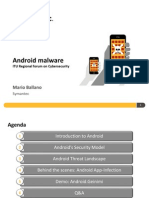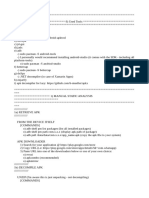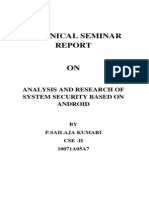0% found this document useful (0 votes)
60 views8 pagesAndroid Malware Analysis Guide
This document provides an introduction to Android malware analysis, detailing the tools and methods used for analyzing malicious applications on the Android platform. It discusses the structure of Android applications, the permissions they require, and various analysis tools like Dexter, Anubis, and APKInspector. The document also includes a case study of a sample malware application, outlining its functionalities and the data it attempts to steal.
Uploaded by
zekuelbouzraziCopyright
© © All Rights Reserved
We take content rights seriously. If you suspect this is your content, claim it here.
Available Formats
Download as PDF, TXT or read online on Scribd
0% found this document useful (0 votes)
60 views8 pagesAndroid Malware Analysis Guide
This document provides an introduction to Android malware analysis, detailing the tools and methods used for analyzing malicious applications on the Android platform. It discusses the structure of Android applications, the permissions they require, and various analysis tools like Dexter, Anubis, and APKInspector. The document also includes a case study of a sample malware application, outlining its functionalities and the data it attempts to steal.
Uploaded by
zekuelbouzraziCopyright
© © All Rights Reserved
We take content rights seriously. If you suspect this is your content, claim it here.
Available Formats
Download as PDF, TXT or read online on Scribd
/ 8




















































































